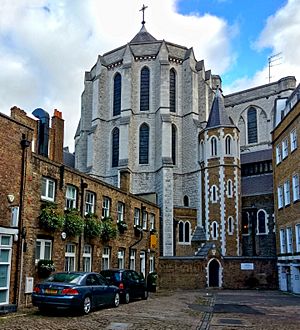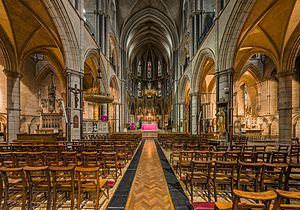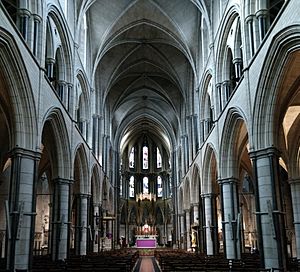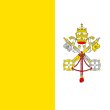St James's, Spanish Place facts for kids
Quick facts for kids St James' Church |
|
|---|---|
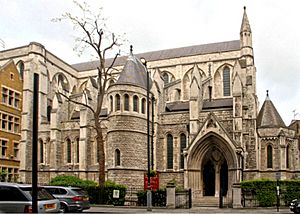 |
|
| 51°31′5″N 0°9′9″W / 51.51806°N 0.15250°W | |
| Location | London, W1 |
| Country | England |
| Denomination | Catholic |
| History | |
| Dedication | Saint James the Greater and Saint Anne |
| Consecrated | 1949 |
| Architecture | |
| Heritage designation | Grade II* |
| Architect(s) | Edward Goldie |
| Style | Neo-Gothic |
| Completed | 1890 |
| Specifications | |
| Capacity | 800 |
| Length | 195 feet |
| Width | 92 feet |
| Height | 67 feet |
| Materials | Stone and marble |
| Bells | 1 |
| Administration | |
| Archdiocese | Westminster |
| Province | Westminster |
St James' Church is a big Catholic church in London. It's built in a style called English Gothic, which looks like old churches from the Middle Ages. Even though it's on George Street now, it's still linked to Spanish Place. That's because it used to have a special connection with the Spanish Embassy. This church is also a 'Grade II* listed building', which means it's a very important historic place.
Contents
Where to Find St James' Church
You can find St James' Church on George Street in Marylebone, London. It's right behind the famous Wallace Collection and near Marylebone High Street.
A Look Back: History of the Church

Early Days and the Spanish Embassy
Long ago, during the time of Queen Elizabeth I, the Spanish Ambassador used a palace and chapel in Ely Place. For many years, this chapel was a safe place for English Catholics to worship. This was important because, at the time, Catholic worship was often restricted.
Later, after King Charles II returned to the throne, the Spanish Embassy moved. It eventually settled at Hertford House, which is now where the Wallace Collection is. In the late 1700s, a new chapel was built there. This happened after new laws made it easier for Catholics to worship. Many of the religious items in the church today came from this older chapel. In 1827, the Spanish Embassy no longer officially ran the chapel. It was then given to the local Catholic leaders in London.
The Church's Spanish Connection Today
Even though the official link ended, St James' Church still has many reminders of its Spanish past. For example, you can see the personal flag of King Alfonso XIII of Spain inside the church. The people of St James' have always remembered how much Spain helped them during difficult times. An unofficial connection with the Spanish Embassy continues to this day.
Building the New Church
For many years, there was a worry that the old chapel was on rented land and the lease couldn't be renewed. People started raising money to buy a new piece of land and build a new church. It was hard to find a suitable spot nearby.
A story says that the priest at the time, Canon William Barry, prayed a lot for a new site. Soon after, the land where the current church stands became available for sale. It cost £30,000, which was exactly how much money had been collected! The land was bought, and a competition was held to design the new church. Edward Goldie, whose great-grandfather designed the old chapel, won. The new church, though not fully finished, opened on September 29, 1890.
The Church's Consecration
A church can only be officially 'consecrated' (made sacred) once all its building debts are paid off. St James' Church was consecrated on July 28, 1949, by Bishop George Craven. This was special because he was also the parish priest at the time. The consecration had been planned twice before but was delayed. Once in 1935 due to the death of a Cardinal, and again in 1940 because of the Second World War.
In 1908, a special service was held at St James' for King Carlos I of Portugal after he passed away. Edward VII and Queen Alexandra of England attended this service. This was a very important event because it was the first time a British monarch had attended a Catholic service since King James II.
Exploring the Church's Architecture
Design and Style
St James' Church is designed in an early Gothic style. It's built entirely of stone, which gives it a grand and majestic feel, especially because of its height. The arches inside the main part of the church are supported by pillars decorated with marble. The way the stone ceiling is built makes it feel light and open, not heavy.
The main entrance on George Street looks like the entrance to Lichfield Cathedral. Many other details inside the church are inspired by the best English Gothic designs from the 1200s. You can see similarities to famous places like Salisbury Cathedral and parts of Westminster Abbey.
The Chancel and Apse
The chancel, which is the area around the altar, is considered one of the most artistic in London. It has a high arch that reaches up to the vaulted roof. This part of the church reminds visitors of grand French cathedrals.
The back part of the chancel, called the apse, has seven sides. In its lower section, there are seven pointed arches filled with beautiful artwork. The middle panel shows the Holy Spirit coming down upon Mary and the Apostles. The other six panels show symbols related to the Holy Eucharist from the Old Testament. High on the wall, above the choir seats, you can see two golden crowns. These marked the special places where King Alfonso and Queen Ena of Spain would sit when they visited the church.
Statues and Orientation
On one side of the church, there's a large marble statue of Saint James the Greater, who is the church's patron saint. He carries a sword and a palm, which represent his martyrdom, and a staff and bag, like a pilgrim. Across from him, near the center of the church, is a statue of Our Lady, Queen of Heaven. This statue is covered in gold leaf, except for her red shoes. It was made locally in 1840 and is thought to be one of the first statues put in a London church after the Reformation.
Usually, churches are built to face east, so that during morning services, the priest and people face the rising sun. This symbolizes Christ and his Second Coming. However, St James' Church is built facing a different direction.
Church Services and Worship
On Sundays and important feast days, a special solemn Mass is held in Latin. A professional choir sings, and the organ plays a mix of polyphony and Gregorian chant. Sometimes, special evening prayers called Solemn Vespers are also held. On these days, Mass is also celebrated several times in English.
The church is well-known for offering the Sacrament of Confession every day at set times. Other religious practices, like Holy Hours, Benediction, saying the Rosary, and the Stations of the Cross, are also part of the church's life.
The Church Organ
The organ at St James' Church is located above the sanctuary. It was built in 1922 by A. Hunter & Son. Because the church has unique acoustics (how sound travels), the organ was specially tuned right there in the building. It still sounds exactly as it did when it was first built. Hunter built many great organs, but this one is considered one of his best. Some parts of the current organ, including five sets of pipes, came from an even older organ that was in the original Spanish Chapel. The organ today has 53 stops and can be played using three keyboards and foot pedals.
Getting to St James' Church
| Service | Station/stop | Lines/routes served | Distance from St. James's |
|---|---|---|---|
| London Buses |
George Street |
2, 13, 74, 139, 274 | 200yds |
| London Underground |
Baker Street | 500yds | |
| Bond Street | 450yds |
See also
 In Spanish: Iglesia de Santiago el Mayor (Londres) para niños
In Spanish: Iglesia de Santiago el Mayor (Londres) para niños
- St James the Greater
- St. James' Church (disambiguation)
- Embassy chapel
- St Etheldreda's Church, London
- Church of Our Lady of the Assumption and St Gregory
- Sardinian Embassy Chapel


